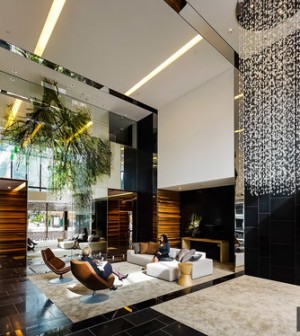- 4 Unexpected Things I’ve Learned From Buying My First Mobile Home Park
- How Ironic: America’s Rent-Controlled Cities Are Its Least Affordable
- U.S. homes are still a bargain on the international market
- Getting The Best Possible Quality Photos On MLSs and Syndicated Sites
- Home buyers in these markets have the upper hand
The Apartment Lobby: 5 Ways to Make It Welcoming & Safe

Lobbies can be luxurious and grand with high ceilings, elaborate moldings, marble flooring, and elegant furnishings that reflect another era when vintage apartment buildings were built with sprawling entry areas. Nowadays, even when smaller, lobbies may be coolly modern with large windows to allow in light and provide spectacular views and display hip, comfortable seating for a contemporary vibe.
No matter the size of the building, creative lobby interior design can make a great first impression, providing a welcoming and comforting entry for tenants, owners, and guests as they take the stairs or wait for the elevator.
“Think of it as the front door of your house,” says Diana Pittro, executive vice president of RMK Management Corp., a development and property management firm based in Chicago. And your choices needn’t break the bank but should offer several key features. A modest investment in time and money can make the difference in securing another lease — or sale.
These five features of interior lobby design can make a world of difference:
#1: Secure entry way for apartment safety
In many smaller buildings without a doorman or concierge, protecting tenants from intruders is a concern. For residents, install the best deadbolt key system available, or go the newer route with a magnetic card or fob key system like many hotels do.
For visitors, install a buzzer system in an outer entry that’s well lighted and has a door behind it that closes securely. “You don’t want anyone waiting in a dark area where they don’t feel safe,” says Pittro. A video camera to record all comings and goings is a good idea, she adds. Video systems that were once expensive have come way down in price.
Good lighting inside the apartment lobby and directly outside the building will make anyone entering or leaving feel much safer. It’s also a plus to have a system that stays lighted all the time, which has become much more affordable as the cost of energy-efficient LED lighting has fallen dramatically.
Additionally, install lighting on separate switches and with dimmers to vary lighting levels, for reasons of safety and decor, says Mary Cook of the design firm Mary Cook Associates in Chicago.
#2: Floors & mats to prevent slipping and falling
Daily upkeep is a must, especially with snow and heavy rain, which brings in mud and dirt. To combat these problems, roll out rubberized mats to protect floors and keep tenants and visitors from slipping and falling, says designer Allston Lipscomb, co-founder of the New York design firm The 3rd Floor Lab, which has decorated numerous lobbies.
The easiest, most affordable floors to care for that will continue to look great over time, according to Cook, are:
- Hardwood or laminate hardwood
- Porcelain tiles that can resemble wood and other materials
- New luxury vinyls
- Stained concrete, which is used by many retailers with high traffic
Also, if the budget permits, Cook suggests considering natural stone.
#3: Mail & package area
Unless you’re going to deliver mail and packages to each apartment daily, set aside a space, even a small one, with lock boxes where residents can retrieve mail and packages, or package slips, with the packages stored in another area for safety. Many apartment buildings with larger budgets now set up virtual concierges that let residents know they’ve received a package, sometimes on an electronic board in the lobby or through an app.
#4: Updated color palettes
Make your choices in the warm, soft, neutral family, like grays and browns, which appeal to the largest audience and wear well. Of course, Pittro says, you can add a dash of color for a smart accent.
While many residential buildings avoid wallpaper because it’s expensive to buy and hang and less practical than paint, many vinyls today look smart, wear well, and even can mimic expensive fancy paint finishes, grass cloths, woods, and stones, Cook says. If you go with paint, select an eggshell finish to make it easy to wash.
#5: The right furnishings
If there’s room, select pieces with a modern and lighter look rather than heavy and traditional because they’ll convey a greater sense of visual space. The exception? When a building has a vintage character you want to bring out, Lipscomb says. Furnishings with glass surfaces or mirrors expand space, as do mirrors on the walls.
Lipscomb also suggests using a mirror in an elevator and hallway for the same reason — and for safety. If a lobby is large enough, it might become a place where residents interact rather than just pass through, says Cook. But don’t overcrowd the area because good circulation is important, and that is one of the space’s primary functions.




 100% Secure
100% Secure
You must be logged in to post a comment Login